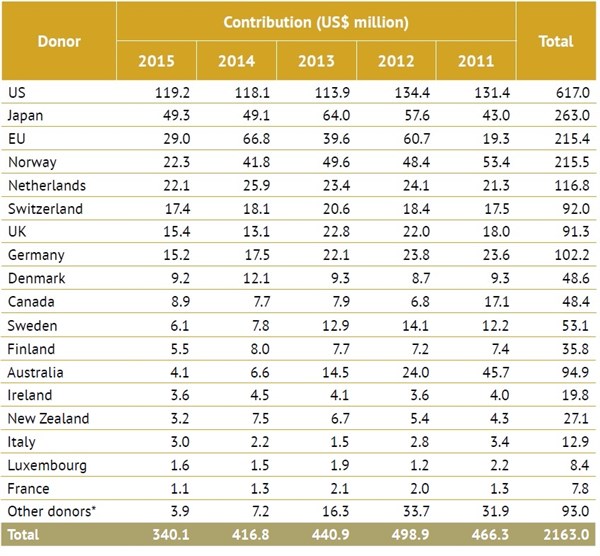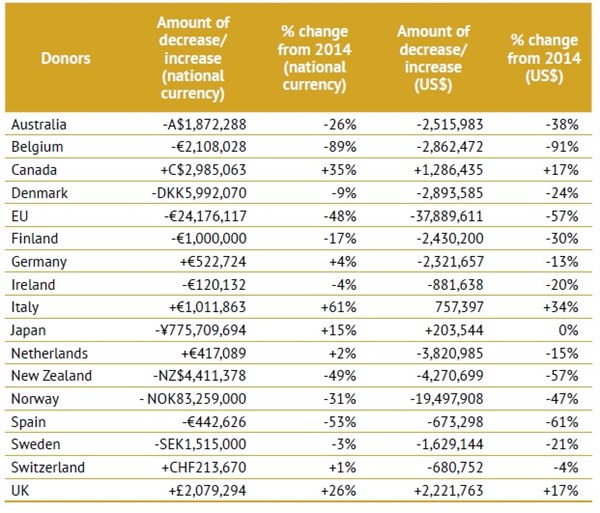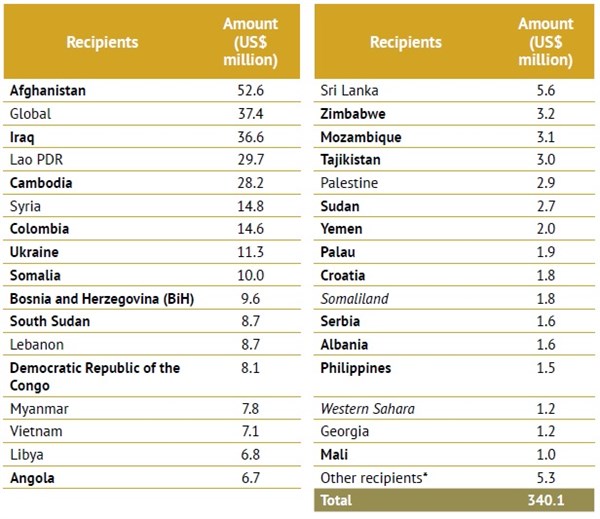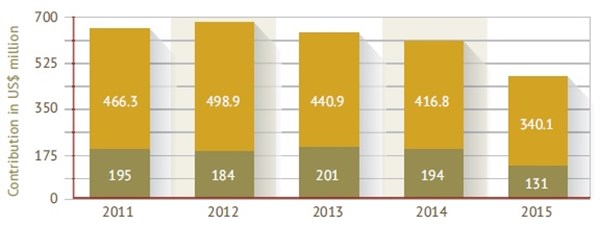Landmine Monitor 2016
Support for Mine Action
Article 6 of the Mine Ban Treaty on international cooperation and assistance recognizes the right of each State Party to seek and receive assistance from other States Parties in order to fulfill its treaty obligations. This chapter focuses on financial support for mine action provided for calendar year 2015 by affected countries and international donors. Cooperation and assistance, however, is not only limited to financial assistance. Other forms of assistance can include the provision of equipment, expertise, and personnel as well as the exchange of experience, know-how, and best-practice sharing.
2015 Figures and Trends
- Total contributions (international and national): Thirty-five donors and 14 affected states contributed US$471.3 million in international and national support for mine action in 2015[1]; this is $139 million less than in 2014 (a 23% decrease).
- International contributions accounted for 72% of overall support for mine action in 2015, while states’ contributions to their own national mine action programs accounted for the remaining 28% of global funding.
- Donors contributed $340.1 million in international support for mine action to 41 affected states and three other areas. This represents a decrease of nearly $77 million from 2014 (an 18% decrease).
- National contributions: The Monitor identified 14 affected states that provided $131.2 million in contributions to their own national mine action programs, $62.4 million less than in 2014 (a 32% decrease), when 13 affected countries reported contributing $193.6 million.
- Contributions from the top five donors—the United States (US), Japan, the European Union (EU), Norway, and the Netherlands—amounted to more than $240 million and accounted for 71% of all international funding.
- The top five recipient states—Afghanistan, Iraq, Lao PDR, Cambodia, and Syria—received a combined total of $162 million, representing 48% of all international contributions.
- International funding was distributed among the following sectors: clearance and risk education (64% of all funding), victim assistance (7%), capacity-building (1%), advocacy (0.5%), and stockpile destruction (0.5%). The remaining 27% was not disaggregated by the donors.
International Contributions in 2015
In 2015, 35 donors contributed $340.1 million in international support for mine action in 41 affected states and three other areas (down from 42 states and three areas in 2014), a decline of $76.7 million from the $416.8 million reported in 2014.[2]
This is the third year running that donors decreased their international mine action assistance, and the first time since 2005 that international support dropped below $400 million. In 2015, international support fell more sharply (18% decrease) than in 2014 (5% decrease) or 2013 (12% decrease).
International support for mine action: 2005–2015
In 2016, donors hosted three international pledging conferences during which they committed resources to support mine action activities as well as the treaty’s implementation support unit:
- In March, Chile hosted in Geneva the first International Pledging Conference for the Implementation of the Anti-Personnel Mine Ban Convention, which aimed at renewing and strengthening donors’ commitment to mine action. Sixty-nine delegations participated in the pledging conference, including 52 States Parties, two states not party, and 15 other organizations. In total, 20 States Parties made pledges to the treaty implementation support unit, and three States Parties added details regarding their future commitments for support to mine action;
- In July, Canada, Germany, Japan, Kuwait, the Netherlands, and the US co-hosted in Washington, DC a Pledging Conference in support of Iraq. Funding for demining was one of four issues addressed during the conference, with eight donors pledging financial and technical support;
- In September, Norway and the US co-hosted in New York City a Global Demining Initiative for Colombia ministerial-level meeting in order to secure commitments from donors to support demining activities in Colombia. Nineteen donor countries and the EU participated in the meeting with 15 donors pledging financial and technical support.
At present it is not possible to determine how these conferences will impact overall support for mine action in 2016.
Donors in 2015
In 2015, 27 Mine Ban Treaty States Parties, two states not party, the EU, and five international institutions[3] contributed a total of $340.1 million to mine action.
Contributions by donors: 2011–2015[4] * Other donors in 2015 included: Andorra, Austria, Belgium, the Czech Republic, Estonia, Liechtenstein, Lithuania, Poland, Slovenia, South Korea, Spain, Turkey, the Council of Europe Development Bank (CEB), the UN Office for the Coordination of Humanitarian Affairs (UNOCHA), the OPEC Fund for International Development, the Organization for Security and Cooperation in Europe (OSCE), and the UN Development Programme (UNDP).
* Other donors in 2015 included: Andorra, Austria, Belgium, the Czech Republic, Estonia, Liechtenstein, Lithuania, Poland, Slovenia, South Korea, Spain, Turkey, the Council of Europe Development Bank (CEB), the UN Office for the Coordination of Humanitarian Affairs (UNOCHA), the OPEC Fund for International Development, the Organization for Security and Cooperation in Europe (OSCE), and the UN Development Programme (UNDP).
The majority of the funding came from just a few donors, with the top five donors contributing a total of $241.9 million, or more than 70% of all international funding for 2015. The US remained the largest mine action donor and alone provided more than one-third of all international mine action support in 2015. Japan ranked second with nearly 15% of all contributions, while the next three donors—the EU, Norway, and the Netherlands—provided more than $20 million each. Canada re-entered the top 10, replacing Finland, which reduced its contributions by a total of $2.4 million. Sixteen donors contributed less than $1 million each, compared to 13 in 2014.
Support from States Parties in 2015 accounted for more than half of all donor funding, with 27 countries providing some $190 million. While this represents a decline from the $230 million recorded in 2014, States Parties’ total contributions to mine action in 2015 was proportionally similar to all support in 2014. The top five State Party contributors—Japan, Norway, the Netherlands, Switzerland, and the United Kingdom (UK)—provided $126.5million (37% of all support).
In 2015, the EU and its member states[5] contributed a total of $113.5 million and accounted for 33% of total international support reported, down from $166 million provided in 2014 (40% of total international funding for that year).
International funding for mine action in 2015 decreased by $76.7 million compared with 2014. Thirteen donors decreased their funding, led by the EU ($37.8 million down) and Norway ($19.5 million down), who together accounted for $57 million of the global decline. Two donors from 2014 did not report any contribution to mine action in 2015: Saudi Arabia and the Common Humanitarian Fund.
In contrast, four donors contributed more in 2015 than they did in 2014; including a $2.3 million increase from the UK. Canada and the US increased their assistance by more than $1 million each. Four new donors—one State Party, and three institutions—were also identified in 2015: Poland, the CEB, UNOCHA, and the UNDP.
Summary of major changes in 2015
|
Change |
Donors |
Combined Total |
|
Decrease of more than $10 million |
The EU and Norway |
$57.3 million decrease |
|
Decrease of less than $10 million |
Australia, Belgium, Denmark, Finland, Germany, Ireland, the Netherlands, New Zealand, Spain, Sweden, and Switzerland |
$25.5 million decrease |
|
Increase of more than $1 million |
Canada, the UK, and the US |
$4.6 million increase |
|
Increase of less than $1 million |
Italy |
$0.7 million increase |
|
Donors from 2014 that discontinued their support in 2015 |
The Common Humanitarian Fund, and Saudi Arabia |
$0.7 million provided in 2014 |
|
New donors in 2015 |
Poland, CEB, UNOCHA, and the UNDP |
$1.5 million provided in 2015 |
As detailed in the table below, changes in the exchange rates between national currencies and the US dollar negatively affected the US dollar value of international contributions.
For instance, when expressed in US dollar terms, mine action international support fell in a dozen countries and the EU, with the biggest decreases recorded in Belgium (-91%), Spain (-61%), the EU (-57%), and Norway (-47%). Whereas in national currency terms, declines were recorded in nine countries and the EU, and were less pronounced, although they remain significant in most instances. Similarly, whereas seven states reported increases in their mine action contributions in 2015, after conversion into US dollars, increases were smaller percentage-wise and only observed for four of them: Canada, Italy, Japan, and the UK.
Changes in mine action funding in national currency terms and US$ terms[6]
Funding paths
Donors contributed to mine action through several trust fund mechanisms, notably the UN Voluntary Trust Fund for Assistance in Mine Action (VTF) administered by UNMAS and the ITF Enhancing Human Security (established by the government of Slovenia and formerly known as the International Trust Fund).
In 2015, contributions to the VTF totaled $52.6 million from 19 donors, compared to some $45 million from 22 donors in 2014.[7] Several small donors used the VTF to contribute to mine action.[8] Twelve donors and two international institutions allocated $7 million in 2015 through the ITF for mine action programs in seven states and one area, as well as for global activities.[9]
Other organizations that received a significant proportion of contributions in 2015 included Norwegian People’s Aid ($24.8 million), Halo Trust ($20.8 million), the International Committee of the Red Cross (ICRC) ($11.5 million from nine donors), and the Geneva International Centre for Humanitarian Demining (GICHD) ($10.8 million from seven donors).
Recipients
A total of 41 states and three other areas received $302.7 million from 31 donors in 2015. A further $37.4 million, designated as “global” in the table below, was provided to institutions, NGOs, trust funds, and UN agencies without a designated recipient state or area.[10]
Afghanistan received the largest amount of funding ($52.6 million) from the largest number of donors (17). Nine states, or one-fifth of all recipients, had only one donor.[11]
List of international support recipients in 2015
Note: States Parties to the Mine Ban Treaty are indicated in bold; other areas are indicated by italics.
* Other recipients in 2015 included: Armenia, Azerbaijan, Central African Republic, Egypt, India, Jordan, Kosovo, Marshall Islands, Mauritania, Peru, Solomon Islands, and Thailand. Each received less than $1 million.
As in previous years, a small number of countries received the majority of funding. The top five recipient states—Afghanistan, Iraq, Lao PDR, Cambodia, and Syria—received 48% of all international support in 2015.
In 2015, 33 states and areas experienced a change of more than 20% in funding compared to 2014, including 11 recipients receiving less support and four recipients receiving no new support. Syria[12] was the recipient with the largest increase, receiving $13.4 million more than in 2014, while Angola[13] was the recipient with the largest decrease, receiving $25.9 million less than in 2014. These fluctuations may be a reflection of shifts in donor priorities and changes in local situations, as well as the closing of some programs.
Regional support in 2015
The East and South Asia and the Pacific region received the highest share of international support at 40%; followed by the Middle East and North Africa (22%), Sub-Saharan Africa (14%), Europe, the Caucasus, and Central Asia (9%), and the Americas (4%).
While support to the first two regions remained relatively unchanged in 2015, the share of support going to Sub-Saharan Africa declined by more than 40% compared to 2014 as a result of substantial drops in support provided to Angola (-80%) and to Mozambique (-70%), which declared itself to be mine-free in 2015.
The proportion of funding going to Europe, the Caucasus, and Central Asia also decreased by 40% in 2015, which is the result of a return to a normal level of funding following a significant disbursement of EU funds to Turkey for clearance activities in 2014.
International support for mine action per region: 2014–2015
|
Region |
2015 contribution (US$ million) |
2014 contribution (US$ million) |
Percentage change from 2014 |
|
East and South Asia and the Pacific |
136.6 |
149.8 |
-9% |
|
Middle East and North Africa |
74.0 |
69.5 |
+6% |
|
Sub-Saharan Africa |
46.4 |
78.3 |
-41% |
|
Europe, the Caucasus, and Central Asia |
31.0 |
51.5 |
-40% |
|
Americas |
14.7 |
11.6 |
+27% |
|
Global |
37.4 |
56.0 |
-33% |
|
Total |
340.1 |
416.8 |
|
Funding by thematic sector
In 2015, 64% of mine action funding supported clearance and risk education activities. Victim assistance support dropped by $4 million from 2014, but still represented 7% of total international support to mine action. Stockpile destruction received less than $1 million, donated by Germany for the destruction of Ukraine’s PFM-1 landmines through the NATO Support Agency.
Various funding represented 27% of all international support to mine action. This includes contributions not disaggregated by the donors, as well as funding not earmarked for any sectors. Unearmarked funding represented more than 10% ($11.9 million) of all various funding in 2015.
Contributions by thematic sector in 2015[14]
|
Sector |
Total contribution (US$ million) |
% of total contribution |
No. of donors |
|
Clearance and risk education |
218.6 |
64% |
23 |
|
Various |
90.2 |
27% |
25 |
|
Victim assistance |
24.2 |
7% |
17 |
|
Capacity-building |
4.4 |
1% |
8 |
|
Advocacy |
2.2 |
0.5% |
8 |
|
Stockpile destruction |
0.5 |
0.5% |
1 |
|
Total |
340.1 |
100% |
N/A |
Note: N/A = not applicable.
Clearance and risk education
In 2015, $218.6 million, or 64% of all reported support for mine action, went toward clearance and risk education activities. This represents a decrease of $63.2 million from 2014.
Five of the 10 largest donors—the US, Japan, the EU, Norway, and the UK—provided three-quarters of all support to clearance and risk education ($167.1 million).
Many donors reported clearance and risk education as a combined figure. Twenty-three donors did, however, indicate contributions specifically for clearance activities, providing a total of $106 million in 33 countries and other areas (21 States Parties, one Signatory, eight states not party, and three other areas).
Twelve donors reported contributions totaling $6.1 million specifically for risk education projects in 10 countries. Iraq received the most risk education-specific funding with $1.5 million.
Victim assistance[15]
Direct international support for victim assistance activities reached $24.2 million in 2015, down from $27.7 million in 2014. This represents 7% of all reported support for mine action in 2015, about the same share as in 2014 and 2013.
Seventeen[16] of the 35 donors identified reported contributing to victim assistance projects in 10 States Parties, five states not party, and one other area.[17] Most mine-affected countries did not receive any direct international support for victim assistance.
The top three victim assistance donors—the US, Germany, and Switzerland—provided 63% ($15.2 million) of all victim assistance funding in 2015.
Eight donors reported contributing $11.9 million, half of all support to victim assistance in 2015, through the ICRC or national Red Cross societies.
Advocacy & capacity-building
In 2015, less than 1% of all reported support for mine action went toward advocacy activities ($2.2 million), this represented a drop of more than $20 million compared to 2014. Of the 35 donors reporting international contributions to mine action, eight reported supporting advocacy activities.
Eight donors provided $4.4 million—1% of all international support—to support capacity-building activities in five States Parties, two states not party, and one other area.
National Contributions in 2015
While there has been more transparency from affected states, overall national contributions to mine action continue to be under-reported. Few States Parties report national funding in their annual Article 7 reports.[18] States Parties such as Algeria and Iraq, as well as states not party India, Sri Lanka, and Vietnam—all mine-affected states with significant contamination and major clearance operations, usually conducted by the army—have never reported annual expenditures.
Fourteen affected states reported $131.2 million in contributions to mine action from their national budget in 2015, some $62 million less than the $193.6 million reported in 2014 (a 32% decrease).[19] This decrease is largely the result of less support provided by Angola to its mine action program, with a total contribution amounting to $60 million in 2015 (half as much as in 2014, when it provided more than $120 million). Nevertheless, Angola still accounted for 43% of all national funding for 2015. Additionally, four States Parties reported contributing a large part of their own mine action programs: Bosnia and Herzegovina ($13.2 million, 58% of total program cost), Chile ($4.4 million, 100%), Croatia ($30.8 million, 56%), and Peru ($1.4 million, 88%); as did state not party Lebanon ($9.0 million, 52%).
Five-year support to mine action 2011–2015
Over the past five years (2011–2015), total support to mine action amounted to $3.1 billion, an average of about $614 million per year.
Although data about national support remains incomplete, such support has accounted for about 30% of total mine action funding over the period, and amounted to approximately $905 million.
International support totaled $2.2 billion, an average of $430 million per year, and represented 70% of all support. Three donors—the US, Japan, and Norway—contributed $1.1 billion, almost 50% of total international support. Three other donors—the EU, the Netherlands, and Germany—contributed more than $100 million each. Support from States Parties accounted for 60% of all international funding with $1.3 billion provided.
Between 2011–2015, the top four recipients—Afghanistan ($360.8 million), Iraq ($174.5 million), Lao PDR ($164.7 million), and Cambodia ($149.7 million)—received 40% of all international contributions.[20]
Summary of contributions in US$ million: 2011–2015
[1] This figure represents reported government contributions under bilateral and international programs for calendar year 2015, as of October 2016. All dollar values presented in this chapter are expressed in current dollars. Mine action support includes funding related to landmines, cluster munitions, and unexploded ordnance, but is rarely disaggregated. State reporting on contributions is varied in the level of detail and some utilize a fiscal year other than the calendar year.
[2] Data for 2015 on international support to mine action is based on reviews of Mine Ban Treaty Article 7 reports, Convention on Cluster Munitions Article 7 reports, Convention on Conventional Weapons (CCW) Amended Protocol II Annual Reports, ITF Enhancing Human Security Annual Report 2015, UNMAS Annual Report 2015, and answers from donors to questionnaires. Thirteen of the 27 States Parties documented in this chapter reported international funding for mine action in a Mine Ban Treaty Article 7 report for 2015, compared to 15 out of 26 States Parties in 2014.
[3] The CEB, the UNOCHA, the OPEC Fund for International Development, the OSCE, and the UNDP.
[4] The amount for each donor has been rounded to the nearest hundred thousand. The total amount of international support for 2013 was revised to include a contribution from the EU to the Philippines that was not previously reported by the Monitor. Totals for 2012 and 2011 have also been rectified as a result of database clean-up.
[5] Eighteen EU member states provided funding in 2015: Austria, Belgium, the Czech Republic, Denmark, Estonia, Finland, France, Germany, Ireland, Italy, Lithuania, Luxembourg, the Netherlands, Poland, Slovenia, Spain, Sweden, and the UK.
[6] Average exchange rates for 2015: A$1=US$0.7522; C$1.2791=US$1; DKK6.7263=US$1; €1=US$1.1096; ¥121.05=US$1; NZ$0.7001=US$1; NOK8.0681=US$1; £1=US$1.5284; SEK8.4350=US$1; and CHF0.9628=US$1. US Federal Reserve, “List of Exchange Rates (Annual),” 4 January 2016, www.federalreserve.gov/releases/G5a/current/default.htm.
[7] UNMAS, Annual Report 2015, September 2015, pp. 22–23, www.mineaction.org/sites/default/files/publications/2016 UNMAS Annual Report.pdf.
[8] The small donors included Andorra, Estonia, Liechtenstein, Lithuania, Poland, and South Korea.
[9] ITF Enhancing Human Security, Annual Report 2015, April 2016, pp. 21–22, www.itf-fund.si/public/upload/brosure/itf_ar_2015.pdf.
[10] Four donors provided funding to global activities only: Andorra, Austria, Estonia, and the OSCE.
[11] Armenia, Azerbaijan, Croatia, Egypt, India, Peru, the Philippines, the Solomon Islands, and Yemen.
[12] Despite a dramatic increase in funding received, conflict and instability prevented access to areas requiring clearance and the implementation of a comprehensive mine action program in Syria. Some of the funding received in 2015 was used by international humanitarian demining organizations for clearance, risk education, and victim assistance in Syria. Projects also sought to improve the capabilities of local Syrian organizations, often supported by offices outside the country. See, for example, UNMAS, “Programmes: Syria,” last updated September 2016.
[13] The sharp decrease in international support for mine action in Angola in 2015 is the result of changes in donors’ contributions, notably following the one-year disbursement of EU funds for clearance activities in Angola in 2014 (with $25 million received).
[14] In 2014, international support was distributed among the following sectors: clearance and risk education ($281.8 million, or 68% of total international support), victim assistance ($27.7 million, or 7%), advocacy ($20.7million, or 5%), capacity-building ($14.9 million, or 3%), stockpile destruction ($3.2 million, or 1%), and various activities ($68.5 million, or 16%).
[15] Funding for victim assistance activities is especially difficult to track because many donors report that they provide support for victims through more general programs for development and for the rights of persons with disabilities. In some cases, the Monitor does not include those funds in its reporting. In cases where it is included, it is difficult to estimate to what extent resources effectively reach landmine victims.
[16] Victim assistance donors included: Australia, Belgium, the EU, Finland, France, Germany, Italy, Liechtenstein, the Netherlands, New Zealand, Norway, Spain, Switzerland, Slovenia, Turkey, the US, and the OPEC Fund for International Development.
[17] States Parties recipients of international assistance for victim assistance were: Afghanistan, Bosnia and Herzegovina, Cambodia, Colombia, Democratic Republic of the Congo, Iraq, Mozambique, Somalia, South Sudan, and Ukraine. States not party that received international assistance for victim assistance were: Egypt, India, Lao PDR, Myanmar, and Palestine. Western Sahara was the sole other area that received victim assistance funding.
[18] Only two of the 14 affected states analyzed in this chapter reported national funding for mine action in a Mine Ban Treaty Article 7 report for 2015: Sudan and Zimbabwe. For 2014, only Sudan reported.
[19] Afghanistan, Angola, Bosnia and Herzegovina, Chad, Chile, Colombia, Croatia, Lao PDR, Lebanon, Mauritania, Mozambique, Peru, Sudan, and Zimbabwe.
[20] The last time total support amounted to less than $500 million was in 2005, when it was $418.9 million, according to revised Monitor data.

